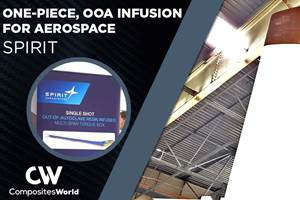Fabrication methods
The most basic fabrication method for thermoset composites is hand layup, which typically consists of laying dry plies or prepreg plies by hand onto a tool to form a laminate stack. Resin is applied to the dry plies after layup is complete (e.g., by means of resin infusion) or, in a variation known as wet layup, each
The most basic fabrication method for thermoset composites is hand layup, which typically consists of laying dry plies or prepreg plies by hand onto a tool to form a laminate stack. Resin is applied to the dry plies after layup is complete (e.g., by means of resin infusion) or, in a variation known as wet layup, each ply is coated with resin and "debulked"or compacted after it is placed.
Several curing methods are available. The most basic is simply to allow cure to occur at room temperature. Cure can be accelerated, however, by applying heat, typically with an oven, and pressure, by means of vacuum. For the latter, a vacuum bag, with breather assemblies, is placed over the layup and attached to the tool, then evacuated before cure. The vacuum bagging process consolidates the plies of material and significantly reduces voids due to off-gassing that occurs as the matrix progresses through its chemical curing stages.
Many high-performance thermoset parts require both heat and high consolidation pressure to cure, conditions that require the use of an autoclave. Autoclaves, generally, are expensive to buy and operate. Manufacturers equipped with autoclaves usually cure a number of parts simultaneously. Computer systems monitor and control autoclave temperatures, pressure, vacuum and inert atmosphere, which allows unattended and/or remote supervision of the cure process and maximizes efficient use of the technique.
When heat is required for cure, the part temperature is "ramped up"in small increments, maintained at cure level for a specified period of time, then "ramped down"to room temperature, to avoid part distortion or warp caused by uneven expansion and contraction. When this curing cycle is complete and after parts are demolded, some parts go through a secondary freestanding postcure, during which they are subjected for a specific period of time to a temperature higher than that of the initial cure, to enhance crosslink density.
Electron-beam (E-beam) curing holds promise as an efficient curing method for thin laminates. In E-beam curing, the composite layup is exposed to a stream of electrons that provide ionizing radiation, causing polymerization and crosslinking in radiation-sensitive resins. X-ray and microwave curing technologies work in a similar manner. A fourth alternative, ultraviolet (UV) curing, involves the use of UV radiation to activate a photoinitiator added to a thermoset resin, which, when activated, sets off a crosslinking reaction. UV curing requires light-permeable resin and reinforcements.
An emerging technology is the monitoring of the cure itself. Dielectric cure monitors measure the extent of cure by gauging the conductivity of ions - small, polarized, relatively insignificant impurities resident in resins. Ions tend to migrate toward an electrode of opposite polarity, but the speed of migration is limited by the viscosity of the resin - the higher the viscosity, the slower the speed. As crosslinking proceeds during cure, resin viscosity increases. Other methods include dipole monitoring within the resin, the monitoring of micro-voltage produced by the crosslinking, monitoring of the exothermic reaction in the polymer during cure and, potentially, the use of infrared monitoring via fiber-optic technology.
Related Content
Novel composite technology replaces welded joints in tubular structures
The Tree Composites TC-joint replaces traditional welding in jacket foundations for offshore wind turbine generator applications, advancing the world’s quest for fast, sustainable energy deployment.
Read MoreVIDEO: One-Piece, OOA Infusion for Aerospace Composites
Tier-1 aerostructures manufacturer Spirit AeroSystems developed an out-of-autoclave (OOA), one-shot resin infusion process to reduce weight, labor and fasteners for a multi-spar aircraft torque box.
Read MoreFrom the CW Archives: Airbus A400M cargo door
The inaugural CW From the Archives revisits Sara Black’s 2007 story on out-of-autoclave infusion used to fabricate the massive composite upper cargo door for the Airbus A400M military airlifter.
Read MoreGKN Aerospace, Joby Aviation sign aerostructures agreement
GKN Aerospace will manufacture thermoplastic composite flight control surfaces for Joby’s all-electric, four-passenger, composites-intensive ride-sharing aircraft.
Read MoreRead Next
VIDEO: High-volume processing for fiberglass components
Cannon Ergos, a company specializing in high-ton presses and equipment for composites fabrication and plastics processing, displayed automotive and industrial components at CAMX 2024.
Read MoreDeveloping bonded composite repair for ships, offshore units
Bureau Veritas and industry partners issue guidelines and pave the way for certification via StrengthBond Offshore project.
Read MoreAll-recycled, needle-punched nonwoven CFRP slashes carbon footprint of Formula 2 seat
Dallara and Tenowo collaborate to produce a race-ready Formula 2 seat using recycled carbon fiber, reducing CO2 emissions by 97.5% compared to virgin materials.
Read More






















